The Pineapple and the Pachyderm: How a Thai Community is Turning Conflict into Coexistence
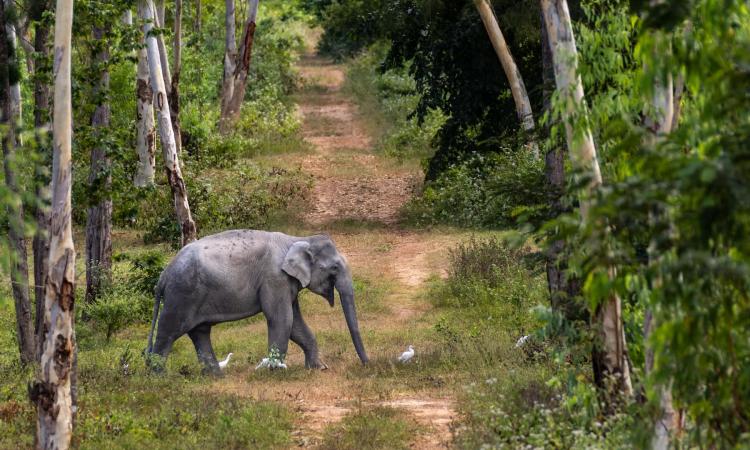
Roengrom Aiamsa-ard, unable to sleep, wakes up at 3 am and begins to prepare her tools for later in the day. She’s anxious. The pineapples in her field are just about ripe, a prime target for herds of hungry elephants. Roengrom (or Pa Rom as many affectionately call her) and her husband have devoted hundreds of hours in preparation for this harvest and depend on it for their family’s well-being. Many farmers guard their fields at night, but it's a dangerous job that she’s no longer able to do due to her age and a chronic leg injury. So she waits in her home, hoping that she’ll still have her bounty to harvest come sunrise.

Sunrise at the border of Ruam Thai Village and Kui Buri National Park.
Her pineapple farm, along with hundreds of other farms, lines the border of Kuiburi National Park in Ruam Thai, a small village located in southern Thailand. The forests are filled with populations of Gaur, Asian Elephants, and even Indochinese Leopards, ecologically precious species that are listed as vulnerable, endangered, and critically endangered, respectively. The village is a bustling place. The rings of ‘ice-cream bicycles’, the hum of zig-zagging pickup trucks filled with local produce, and the footsteps of running school children fill the air each evening.
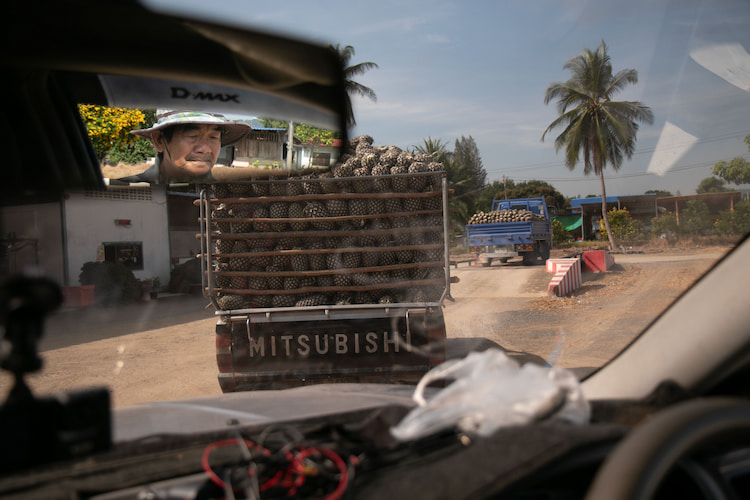
Sa-ard Ngernyouang waits to get his pineapple harvest weighed and sold.
The village was formed in 1978 when the Thai government gave free plots of land (a little over 9 acres (20 rai for farmland, 3 rai in a separate part of town for a house) to each household as an incentive to settle and farm the land. About 150 families took the offer, building houses and growing crops ranging from mangoes to pineapple to jackfruit. The village was fittingly named “Ban Ruam Thai” or “Gathering of the Thai people.” Since then, Ruam Thai has expanded with 600-700 families now calling the village home. A majority of the community are farmers, with pineapple being the most common and lucrative crop. Pineapples harvested in this region are processed (mostly canned) and shipped around the world, contributing to Thailand’s position as the world’s largest producer of pineapple products. The cultivar of pineapples grown in the region are especially sweet and tender, tasting more like candy than fruit and exuding a rich, fruity aroma.
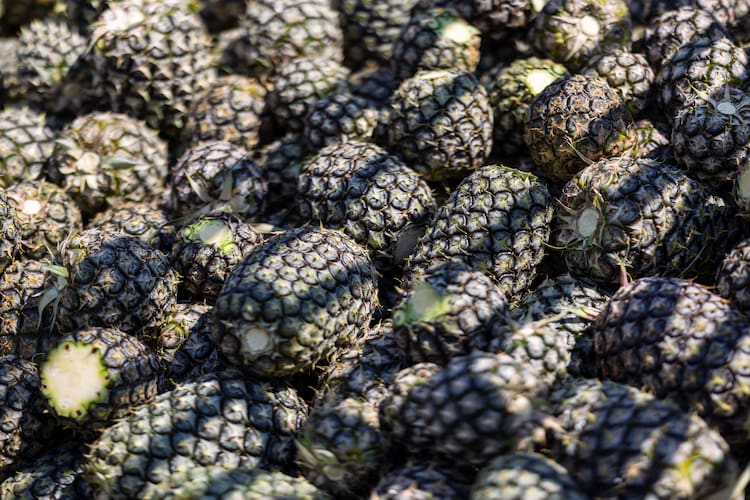
In the cover of night, however, the scent of pineapples attracts wild herds of Asian Elephants to the fields. While elephants typically steer clear of humans and human establishments generally, the food lures them out of the forest and into the croplands. A single elephant herd can destroy an entire season’s worth of income, both by stomping on the crops and by eating the young leaves and pineapples.
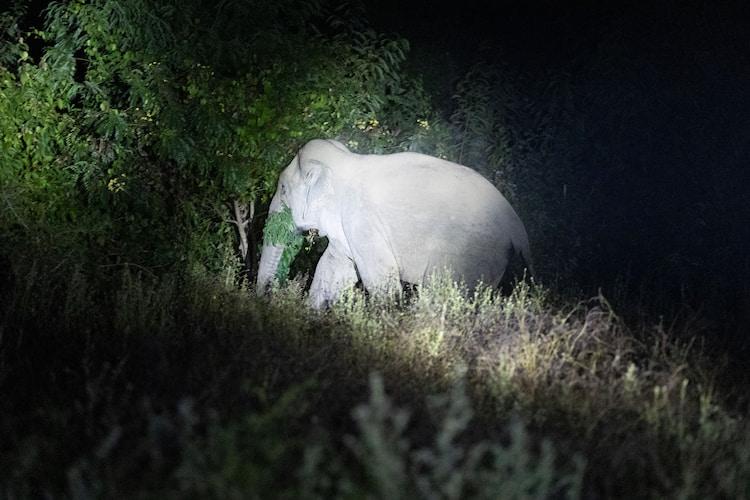
From plowing the soil and planting neat rows of young pineapple shoots to watering, pruning, fertilizing, and finally plucking and cleaning each fruit, Pa Rom and farmers like her are intimately involved in every stage. The care is so meticulous that when young fruit emerges, they wrap hundreds of pineapples in handmade nests of twigs or newspaper to shield them from the sun. Understandably, any damage to this investment, of both effort and money, brings deep frustration and loss.
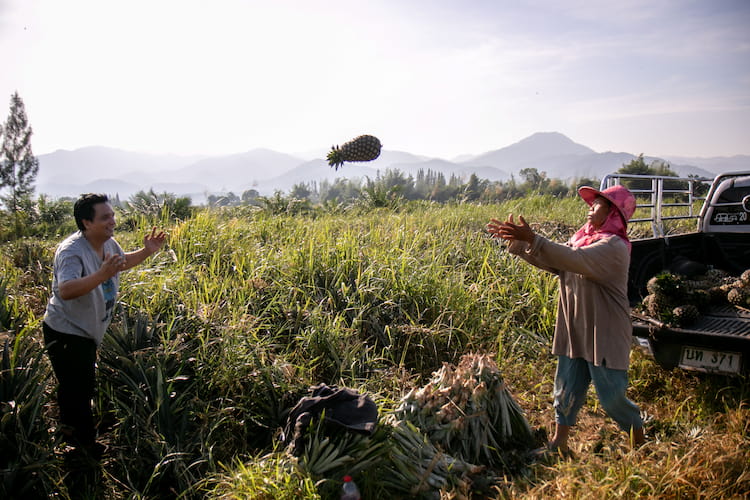
In 1997, tensions over elephant crop damage resulted in the killings of two wild elephants (one was poisoned, the other shot and burned). The incidents sparked national outrage, and in 1999, King Bhumibol Adulyadej (Rama IX) responded by establishing Kui Buri National Park and declaring it a priority to conserve the land and protect the wildlife living there. While the park’s creation improved the situation by giving elephants greater access to food in the forest and reducing their need to venture out, conflict between elephants and farmers over crop damage remains a persistent challenge.
Even today, farmers have to take drastic measures to protect their crops. Many families build nightwatch shelters (small wooden shacks, though some households wire electricity in and even create spaces where the whole family can stay) on their fields. Some choose to stay awake all night, on active lookout for elephants, and then sleep in the day. Others sleep lightly and awake at any sound of disruption, ready to take action. If they see an elephant in their field, they use loud noises to scare it away, using fireworks or even rifles. There are huge costs to the system, both to families and to wildlife.
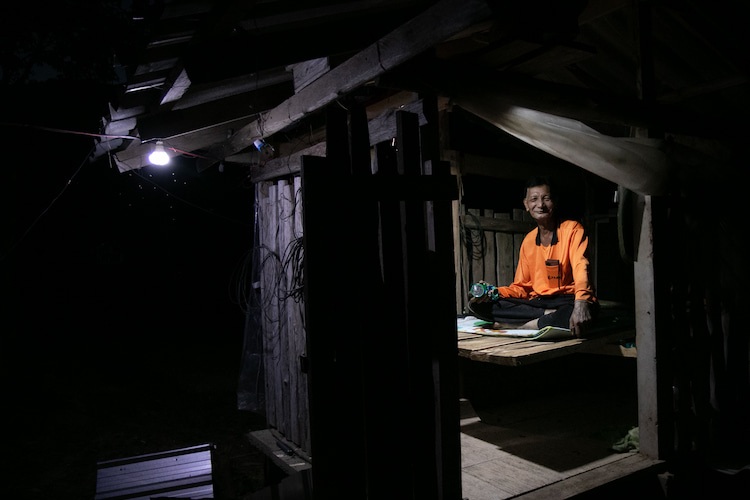
P’ Aod guards his crop from elephants at night in this shelter he built on his field himself.
While some families sleep in these shelters together, a substantial portion of men do this alone. It can be isolating, adds social pressure to families, and can be extremely dangerous. A recently published study (Owen et al., 2024) found that 91% of surveyed farmers in Ruam Thai experienced negative consequences from living next to Elephants, such as fear while night guarding (70%) and loss of sleep (59%). According to data published by Thailand’s Department of National Parks, Wildlife, and Plant Conservation between 2012 and 2024, wild elephants caused 227 human fatalities, many of these during night guarding. And, even though it is illegal, dozens of elephants have been shot to death by farmers. To address this challenge, the government, in partnership with Kui Buri National Park, has trained and deployed park rangers as night guards to patrol the national park and farmland for straggling elephants on motorbikes. These rangers quite literally move entire herds of aggressive elephants by circling them and, similar to the farmers, use loud sounds to push them back into the forest.
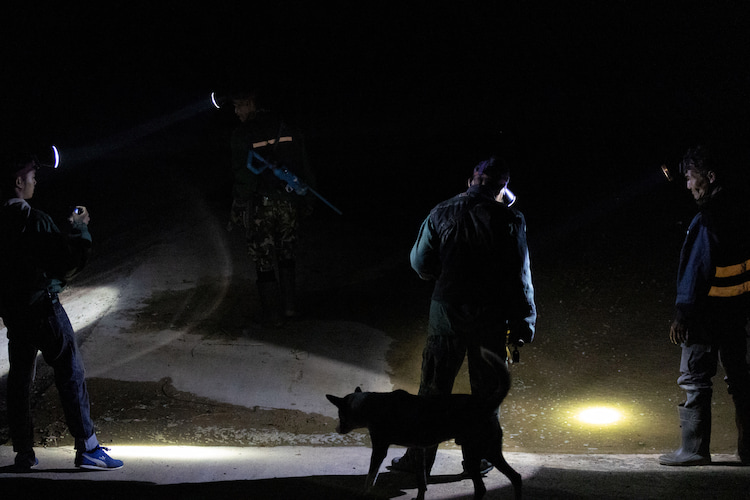
Kui Buri National Park rangers patrol the forest periphery for stray elephants.
They are also, unlike the farmers, however, equipped with drones, motion-activated trail cameras, and safety training that allows them to be more effective. They also do not physically harm the elephants. Still, this is far from a complete solution. Rangers aren’t always able to reach the fields in time; the process can traumatize wild elephants, and it is a dangerous job. Recently, a ranger lost a finger because a firecracker exploded prematurely in his hand, and at any point, wild elephants can charge the rangers. The rangers also (in addition to regularly scheduled patrols at different points in the night) have to wake up at any time they receive an alert from a villager or a ping from the trail cameras that elephants have left the national park.
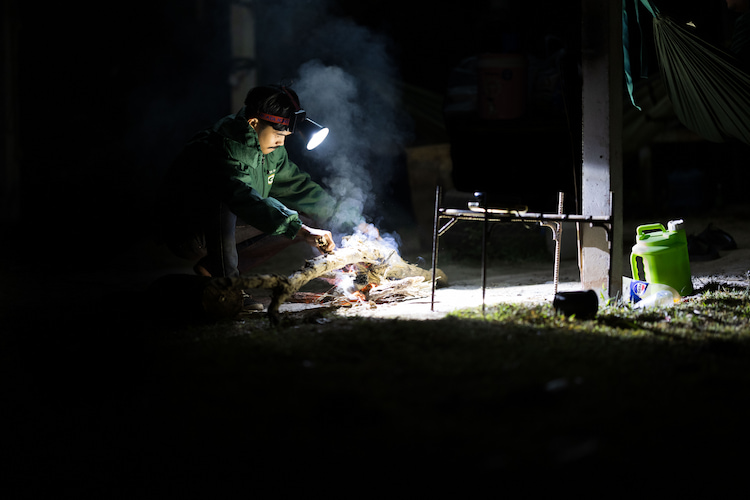
The rangers build a fire to stay warm while on their night patrol shifts.
Enterprising community members have come up with their own innovative solutions to coexist with the elephants. Known as the Kuiburi partnership, there is now a community-led effort in partnership with Kuiburi National Park and World Wildlife Fund (WWF) Thailand started in 2009 to invite and bring tourists to the national park and engage them in local culture. Several times a day, community guides drive tourists into the national park and spot the elephants. There is a queue system where everyone in the village who is trained and interested gets a chance, which ensures that the community benefits from the elephants too and that the revenue is distributed evenly. There is also an emerging tourism economy with villagers opening their homes as homestays or offering home-cooked meals to tourists.

Small wooden boxes housing bee colonies, created as part of the Bee The Change initiative.
Bring The Elephant Home (BTEH), another NGO, is playing a role in supporting community interest in creating and maintaining new sources of revenue. Thailand is increasingly becoming an exporter of honey. Building on this trend and evidence that beehive fences are successful at deterring African Elephants from farmland, BTEH conducted the first study to assess the effectiveness of beehive fences in deterring wild Asian elephants. Based on their findings, BETH runs a project called Bee The Change, where farmers receive bees, hives, fencing, and other materials as well as participate in a year-long training program where they learn how to maintain beehive fences and sell the products. After the year of support, farmers are able to have self-sustaining honey businesses (which they run in addition to their farms), with the profits supplementing lost income from elephant damage.
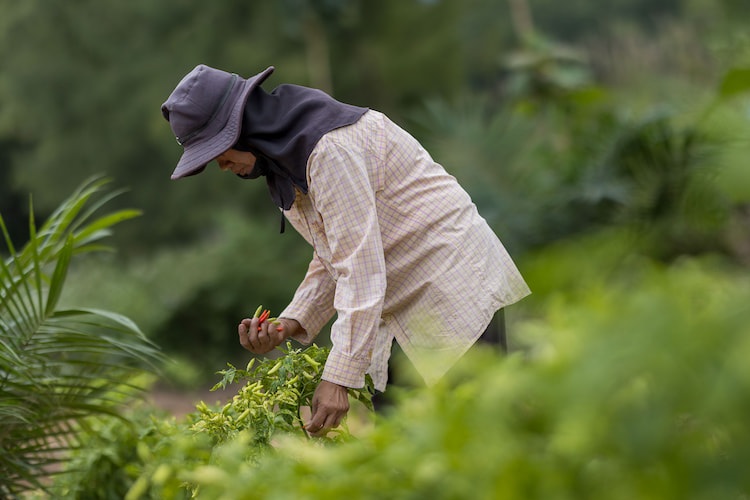
Prachuap Puata, a Tom Yum Project participant, harvests chilies, an elephant-resistant alternative crop.
BTEH also runs the Tom Yum Project, an innovative new program that supports farmers in transitioning from growing pineapples to growing crops like lemongrass, galangal, and chilies (ingredients common in tom yum soup, which the initiative is named after). Local farmers, in partnership with BTEH co-developed and even co-authored research that has shown elephants are far less likely to damage these alternative crops (80% of pineapples were damaged in this plot, as compared to less than 6% of any of these crops). While the pineapple industry is deeply established (the whole system for transporting, selling, and processing the crop is relatively easy and efficient), these alternative crop markets are still developing. BTEH is supporting the local community by training the farmers on best growing practices for these new crops, financially insuring the crops, and even investing in distilling machines to turn the lemongrass into essential oils and training community members on how to make candles, teas, soaps, and lip balm. These finished products can be sold at higher premiums, and greater revenue stays in the community.
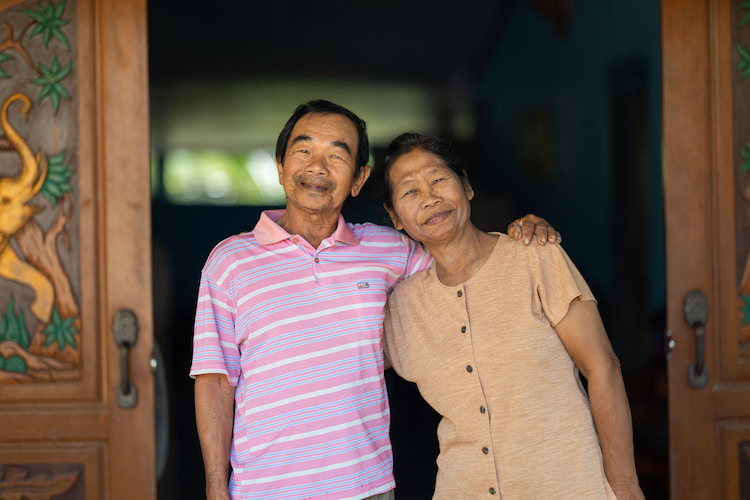
Sa-ard Ngernyouang and his wife, Roengrom Aiamsa-ard, smile outside of their homestay.
This season, Roengrom’s harvest is safe. She’s ecstatic. Like many others in Ruam Thai though, she’s working hard to diversify her income, from guiding visitors through the national park, running a homestay, teaching tie-dye classes, and even raising bees. As Roengrom and other community leaders develop these new strategies, a better world in which coexisting with elephants without fear becomes closer to reality.
Special thank you to Roengrom Aiamsa-ard, Raiwin Sornphet, Akaraphum Pisanwanich, Susie Post-Rust, Chris Sims, Ave Owens, Inga Peterson, Ada Gregory, Christian Ferney, Hillary Train, the Decaminada family as well as Bring The Elephant Home, Duke’s Kenan Institute for Ethics and the Center for Documentary Studies.
To support human elephant coexistence, consider supporting Bring the Elephant Home through sponsoring a wildlife camera, purchasing fair trade products or visiting Kui Buri National park and similar community-benefit tourism locations.
Further Reading:
-
https://sciencescholar.us/journal/index.php/ijhs/article/view/12131
-
https://wwf.panda.org/wwf_news/?283430/KuiburiNationalParkAhomeforhumanandelephants
-
https://oec.world/en/profile/bilateral-product/honey/reporter/tha
-
https://bring-the-elephant-home.org/asia/bee-the-change-ruam-thai/
Discuss this article
Clicking links may earn us commission. . Stock images by Depositphotos.
Subscribe: Stories about wildlife, habitats and heroes
Welcome to Conservation Mag where we celebrate nature preservation through ecotourism and wildlife travel while we look for ways to preserve our heritage by supporting nature conservation. Starting conversations about the positive action people like you and I are taking to make a change.
Quick Links
Work With Us
![]()

